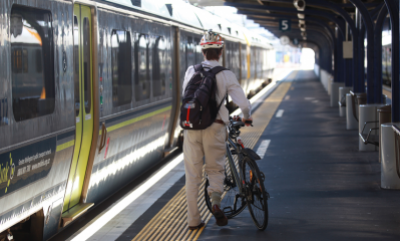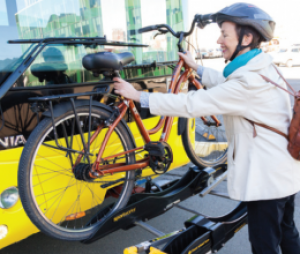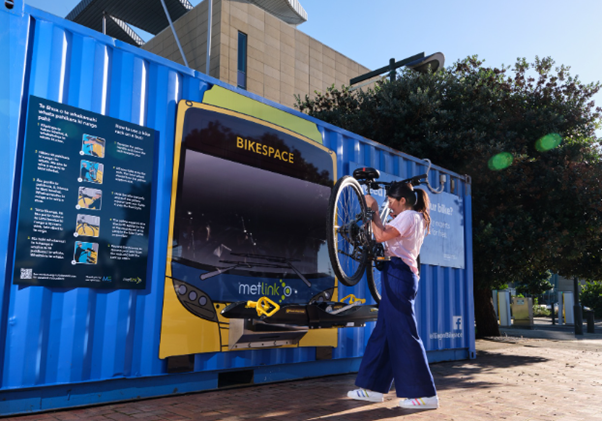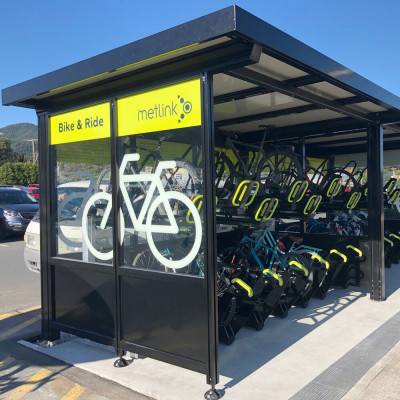Bikes & Scooters
Bike racks on Metlink buses are available for passengers to use, as of 1 July 2025.
The bike racks required modification to adhere to NZTA guidance issued in October last year: ensuring bike racks do not obscure bus headlamps, enabling full visibility in all weather conditions and during hours of darkness, including when travelling through tunnels.
We thank passengers for their patience during this time and are very glad that all Metlink buses with bike racks are operational again.
Active transport for connected journeys
 Active modes such as bikes and scooters help provide a door-to-door transport solution for a growing number of public transport users.
Active modes such as bikes and scooters help provide a door-to-door transport solution for a growing number of public transport users.
We support this in a number of ways:
- Carrying bikes for free on board trains and ferries where practical
- Carrying folding bikes(external link) and scooters for free on buses, trains and ferries where practical
- Introducing bike racks on the entire fleet of new buses
- Providing free bike racks at most train stations
Bikes, scooters, and other items are carried free of charge, but there may not always be space for them, so try to travel in the off-peak period whenever possible
- Drivers and on-board staff are not required to assist you with your bike or scooter
- Be considerate of fellow passengers and let others board first
- Do not ride your bike or scooter on railway station platforms - Walk beside it
- You may carry skates onto our vehicles, but don't wear them on board
- Any gear brought on board must be clean (no muddy shoes or tires)
- Always use a lock and attach owner identification to your bike
- We are not liable for loss or damage to cycles, scooters, skateboards, similar equipment, or any other property that you wish to travel with
Bikes on Buses
All buses running regular Metlink services come with a bike rack fitted, but we can't guarantee that buses replacing trains will have bike racks. The Real time information system is currently unable to display which services will have a bike rack.
On buses fitted with bike racks, passengers can store standard-size bikes on the rack on any service. On services without bike racks (or if the rack is already full), only compact folding bikes and scooters are permitted on board, and must be folded down before boarding. Full size bicycles can't be brought on board the bus.
Racks fit standard bikes with a minimum wheel diameter of 405 mm (16 inches) and a maximum wheel diameter of 735 mm (29 inches, including 700c). The maximum tyre width is 75 mm (3 inches). Each bike can weigh a maximum of 25kg and some electric bikes will need the battery to be removed to bring the e-bike under this weight limit. Bikes with wide handlebars over 750 mm must be loaded on the rack furthest from the bus so that they do not interfere with windscreen wiper function.
Cargo-style bikes, stunt and lowrider bikes and those with fat tyres do not fit on the rack. High-backed child seats and other large accessories that block the driver's visibility are not allowed for safety reasons.
The maximum allowable bike wheelbase is 1168 mm.

 Always load bikes from the front of the bike rack, and at the very front of the bus stop. For safety reasons, we recommend not standing behind another bus or on the road side of a bus when loading or unloading. Children under the age of 13 should be assisted by an adult.
Always load bikes from the front of the bike rack, and at the very front of the bus stop. For safety reasons, we recommend not standing behind another bus or on the road side of a bus when loading or unloading. Children under the age of 13 should be assisted by an adult.
A practice bus bike rack is available for use 24/7 at Bikespace, 55 Cable St next to Te Papa Museum. Alternatively contact sustainabletransport@gw.govt.nz to book our portable demo rack for a practice session at your workplace.
| 1. Kōpēngia te kakau, ā, whakahekea te whata ki a koe. | 1. Squeeze the handle and lower the rack towards you. | |
| 2. Hīkina tō pahikara ki runga i te whata. Me ahu te wīra o mua ki te tāmi kōwhai. | 2. Lift your bike onto the rack. The front wheel should face the yellow support arm. | |
| 3. Āta puritia te pahikara, ā, kūmea te tāmi kowhai. Whakarewaina ki runga o te wīra o mua. | 3. Hold the bike securely and pull the yellow support arm out. Raise it over the front tyre. | |
| 4. Tōna tikanga, ka tau pai te noho o te tāmi kowhai ki runga o te maru wīra, tata rānei ki te anga. | 4. The yellow support arm should fit tightly on top of the tyre or mud guard as close to the bike frame as possible. | |
| 5. Kia hoki whakamuri te tukanga e unuhia ai tō pahikara i te whata, Whakairia te whata. | 5. Reverse the process to remove your bike from the rack and fold the rack up again. |
Disclaimer: Passengers and their bikes travel at their own risk and Greater Wellington Regional Council and their contracted bus companies are not liable for whatever reason (to the extent permitted by law), for any losses, damage, costs or inconvenience suffered by passengers or any other person, or for loss or damage to any property (including bikes).
Lost Property: Bikes left of the rack will be treated as lost property by the relevant bus company who will keep hold of them. Find out more about lost property on Wellington's public transport.
Feedback: If you experience any problems when using the bike racks, please inform the driver immediately. Take note of the bus number above the driver side of the front windscreen and inform the Metlink Service Centre by phone, email, or the online feedback form.

Folding bikes must not exceed the dimensions: 82 cm long x 69 cm high x 39 cm wide. Rims maximum 51cm diameter (about 20 inches). Kickbikes that meet the criteria for folding bikes can also be taken on buses.
Scooters that can be carried by hand are allowed on buses. If possible, scooters should be folded before the bus arrives. When folded, folding bikes and scooters are allowed on every service and are treated as a form of luggage. They must be secure at all times, must not block aisles or doorways, and not occupy a seat. Please do not remove any e-batteries. On board staff may ask you to move your folding bike or scooter if they think it's unsafe for you or other passengers.
Bikes on Trains
Bikes can be carried on most trains on a first-come, first served basis. Each two-car set can take up to three bikes, and Wairarapa trains have a special luggage car that can store bicycles. Batteries don't need to be removed from e-bikes on trains.
Some peak train services do not allow bikes on board.
Hutt Valley, Melling, Kapiti and Johnsonville Lines
Metlink trains have special low-floor carriages that can accommodate bikes on services that allow them. Each two-car train can accommodate up to three bikes, on a first come first serve basis. Look for the bicycle symbol on the outside of the carriage, and in the cycle area inside the carriage.
Cyclists must load, secure, and attend their bike while on board. Bikes must not obstruct doors or aisles, and are to be stored in the bicycle area only. Batteries don't need to be removed from e-bikes on trains.
Wairarapa Line
Wairarapa Line trains can carry bikes in the luggage car, depending on space. The luggage car will always be on the northern end of the platform when the train stops. Bikes and luggage must be lifted into the luggage car and carried up a few steps with a narrow entrance, unlike the trains on the rest of the network. Large cargo-style bikes can't be carried on Wairarapa Line trains.
Cyclists must speak to staff before loading their bikes. Passengers must load their own bikes and luggage into the luggage car while staff supervise. For safety reasons during loading, bikes and luggage should not exceed 30kg in weight, and bikes must be under 180cm in length. Batteries don't need to be removed from e-bikes on trains.
Some peak hour services on the Hutt Valley and Kapiti lines do not allow bikes. To see whether you can bring your bike onto a particular service, check the timetable:
Hutt Valley Line(external link)
If you're at Wellington Station, you can also check the departure screens, which show a bike symbol on services that allow bikes.
Bikes cannot be carried on services to and from special events. That includes timetabled services and any additional services provided.
Buses replacing trains are not guaranteed to have a bike rack, even if the train service it is replacing usually allows bikes. If a bus is fitted with a bike rack, they can only carry two standard bikes, and it is first come first served. Folding bikes and scooters may be carried, as long as there is capacity on board to do so safely.
The Wairarapa line and Hutt Valley lines have frequent bus replacements due to the upgrade work on those lines. Check timetables, service alerts and Buses replace trains page to plan your journey.
During peak times and busy services, compact, fully folding bikes(external link) must be folded down before boarding. Off-peak, the bike may be stored unfolded in the bicycle storage area, however if your fellow cyclists with non-folding bikes require the space, your folding bike will need to be folded to make room.
Folding bikes must not exceed the dimensions: 82 cm long x 69 cm high x 39 cm wide. Rims maximum 51cm diameter (about 20 inches). Kickbikes that meet the criteria for folding bikes can also be taken on trains.
Scooters that can be carried by hand are allowed on trains. If possible, scooters should be folded before the train arrives. When folded, folding bikes and scooters are allowed on every service and are treated as a form of luggage. They must be secure at all times, must not block aisles or doorways, and not occupy a seat. Please do not remove any e-batteries. On board staff may ask you to move your folding bike or scooter if they think it's unsafe for you or other passengers.
Bike & Ride (Bike parking spaces)
Bike parking spaces are available for day use at most train stations throughout the network. We're always working in installing more bike racks and stands, especially at busy stations. Bike parking areas may not be covered by CCTV, so check for the green CCTV signage clearly posted at stations.
Metlink currently only provides bike parking at railway stations, however other local councils may provide bike racks in town centres, public areas or recreation areas.
Bike racks and stands
Bike parking spaces at train stations are free to use if you're not taking your bike with you on the train or bus. They're first come first serve, and are for day use only. Some racks and stands are covered, and some are not. Bike stands hold 4 bikes, cone-style bike racks hold 6 bikes, and the new two-tier bike racks hold 20 or more bikes.
Cycle Lockers and Sheds
Our Cycle Lockers and Sheds provide secure, enclosed storage for your bike, offering additional protection compared to open racks and guaranteed availability throughout your hire period. Lockers and Sheds are available at stations Melling, Ōtaki, Paekakariki, Paraparaumu, Petone, Plimmerton, Porirua, Silverstream, Trentham, Upper Hutt, Waikanae, Wallaceville, Waterloo, and Wellington.
You can hire a locker or shed for 6 or 12 months, with a hire fee and a refundable key bond. For more information or to reserve your space, email CycleLockers@gw.govt.nz with your preferred station.
Using the two-tier bike racks
Dutch-style two-tier bike racks are surrounded by a three-sided shelter. They are designed to accommodate bikes of many different shapes and sizes. The top rack is gas-assisted and the bottom rack features a roller system, both designed to make it easier to use.

Top rack
| Slide the rack straight out by pulling firmly on both handles. |
| Keep the rack straight until it is fully extended and stops, then lower carefully to the ground. |
| Load or unload your bike. Remember to use a bike lock. |
| Return the rack to the stored position by lifting until it is straight, then push in firmly until it stops. |
Bottom rack
| Slide the rack out by pulling the handle until it stops. |
| Load or unload your bike with the front wheel facing the back of the shelter. Remember to use a bike lock. |
| Return the rack to the stored position by lifting the rack slightly, then push in firmly until it stops. |
| Station | Rack spaces | Lockers |
|---|---|---|
| Wellington | public bike racks near Bunny St. | 20 shed spaces |
| Ngauranga | no bike parking | - |
| Petone | 6 spaces | 8 lockers |
| Ava | 6 spaces | - |
| Woburn | 32 spaces in two-tier rack | - |
| Waterloo |
20 spaces in two-tier rack, 32 spaces in other racks |
22 lockers |
| Epuni | 8 spaces | - |
| Naenae | 3 spaces | - |
| Wingate | no bike parking | - |
| Taita | 8 spaces | - |
| Pomare | TBC | - |
| Manor Park | public racks near the bridge | - |
| Silverstream | 6 spaces | 4 lockers |
| Heretaunga | TBC | - |
| Trentham | 16 spaces in two-tier rack | 4 lockers |
| Wallaceville | 16 spaces in two-tier rack | 4 lockers |
| Upper Hutt | 32 spaces in two-tier rack | 16 lockers |
| Station | Rack spaces | Lockers |
|---|---|---|
| Wellington | public bike racks near Bunny St. | 20 shed spaces |
| Ngauranga | no bike parking | - |
| Petone | 6 spaces | 8 lockers |
| Western Hutt | no bike parking | - |
| Melling | 6 spaces | 4 lockers |
| Station | Rack spaces | Lockers |
|---|---|---|
| Wellington | public bike racks near Bunny St. | 20 shed spaces |
| Takapu Road | 4 spaces | - |
| Redwood |
32 spaces in two-tier rack, 6 other spaces |
- |
| Tawa |
16 spaces in two-tier rack, 6 other spaces |
- |
| Linden | 6 spaces | - |
| Kenepuru | no bike parking | - |
| Porirua | 32 spaces in two-tier rack | 8 lockers, 12 shed spaces |
| Paremata | 6 spaces | - |
| Mana | 32 spaces in two-tier rack | - |
| Plimmerton | Temporarily no bike parking (during carpark works) | - |
| Pukerua Bay | 6 spaces | - |
| Paekakariki |
32 spaces in two-tier rack, 12 other spaces |
4 lockers |
| Paraparaumu | 48 spaces in two-tier racks | 44 lockers |
| Waikanae | 12 spaces | 4 lockers |
| Station | Rack spaces | Lockers |
|---|---|---|
| Wellington | public bike racks near Bunny St. | 20 shed spaces |
| Crofton Downs | 6 spaces | - |
| Ngaio | 6 spaces | - |
| Awarua Street | no bike parking | - |
| Simla Crescent | 4 spaces | - |
| Box Hill | no bike parking | - |
| Khandallah | no bike parking | - |
| Raroa | 4 spaces | - |
| Johnsonville | 4 spaces in two-tier rack | - |
| Station | Rack spaces | Lockers |
|---|---|---|
| Wellington | public bike racks near Bunny St. | 20 shed spaces |
| Petone | 6 spaces | 8 lockers |
| Waterloo |
20 spaces in two-tier rack, 32 other spaces |
22 lockers |
| Upper Hutt | 6 spaces | 16 lockers |
| Maymorn | no bike parking | - |
| Featherston | 8 spaces | - |
| Woodside | 4 spaces | - |
| Matarawa | no bike parking | - |
| Carterton |
32 spaces in two-tier rack |
- |
| Solway | 4 spaces | - |
| Renall Street | 4 spaces | - |
| Masterton | 12 spaces | - |
Wellington Region Cycling Information
More information about cycling in the Wellington region can be found on the Greater Wellington Regional Council website(external link).
Last published: Thursday, 8 February 2024 at 5:46 am